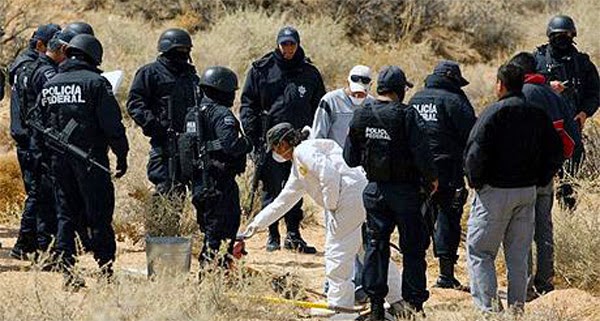Narco gangster reveals the underworld
Cartels have taken cruelty up a notch, says one drug trafficker: kidnapping bus passengers for gladiatorlike fights to the death
On Mexican Federal Highway 101 bus-loads of Mexican citizens and tourists alike were vanishing without a trace. No ransom demands or otherwise were ever made and the authorities were beginning to doubt their original theory of kidnappings. Then they discovered a truth far more grisly and even more surreal than simple kidnappings. Welcome to San Fernando...
San Fernando, a town of 57,000 people and roughly 100 miles from the US border, is no stranger to mass killings and massacres. Only one year before in 2010 the city was famous for another massacre wherein the mass murder of 72 undocumented immigrants took place, this was the first San Fernando Massacre. The Mexican state of Tamaulipas was at the time home to the Los Zetas drug cartel whose headquarters was believed to be in the small village of El Huizachal on the outskirts of San Fernando. It was this group that was responsible for both San Fernando Massacres.
In the first massacre, the killings were the result of a conflict between the immigrants and the cartel, the cartel had bigger guns and won, simple as that. However, in the second San Fernando massacre the Los Zetas were being truly creative in their efforts to resolve an imposing threat from neighbouring drug clans.
In the first massacre, the killings were the result of a conflict between the immigrants and the cartel, the cartel had bigger guns and won, simple as that. However, in the second San Fernando massacre the Los Zetas were being truly creative in their efforts to resolve an imposing threat from neighbouring drug clans.
The bus loads of people were being abducted for the very specific purpose of training them as assassins. Once abducted the women would be sequestered to make-shift barracks where they would be repeatedly raped for the pleasure of the Los Zetas soldiers. This would happen day in and day out until they had eventually gone insane, or the cartel decided that they were for some other reason no longer usable at which point they would be executed.
The men, on the other hand, were chained in a large garage structure that provided little shelter from the elements. Each day they would be put into pairs and given ordinary tools such as hammers, sickles, or even regular wood saws. These tools were meant as weapons for the male captives to use when led into a pit and forced to fight to the death (like the gladiators of ancient Rome). After several rounds of one-on-one gladiator battles to the death, the survivors would be rewarded with their first meal and informed of their new purpose in life as assassins for the Los Zetas drug cartel.
The men, on the other hand, were chained in a large garage structure that provided little shelter from the elements. Each day they would be put into pairs and given ordinary tools such as hammers, sickles, or even regular wood saws. These tools were meant as weapons for the male captives to use when led into a pit and forced to fight to the death (like the gladiators of ancient Rome). After several rounds of one-on-one gladiator battles to the death, the survivors would be rewarded with their first meal and informed of their new purpose in life as assassins for the Los Zetas drug cartel.
This practice was being a carried out in San Fernando for the better part of six months with little intervention from the authorities. The townspeople knew what was happening, but fearing for their lives they never spoke out against the cartel, even when they’re own family members were amongst the “new recruits”.
In a 2012 article in the El Universal, several anonymous residents gave testimony of the events in Tamaulipas. One elderly woman stated: "We could not do anything. We were fighting for our lives and watched helplessly as they were being taken. The abduction of the buses were in full daylight, even outside the bus station. But we could not say anything, we remained silent. We have family, we have children and we cannot leave here." More chilling are the words of her granddaughter: “My mom always reminds us before we leave: if they come for you don’t be trapped alive. So at least we'll have your body and know where you are and lay our flowers.”
Despite the shroud of silence, there are only so many people, especially tourists that can go missing in a six month period before the authorities take notice. In august of 2011 six hundred and fifty Mexican soldiers flooded the streets of San Fernando forcibly removing the local police force and beginning a massive hunt for the Los Zetas base. What they found during their search were the unmarked graves of 193 female victims of rape, torture, and murder, and the male victims forced to fight as gladiators.
The known members of the Los Zetas drug cartel involved in the massacre were arrested in short time, but it is likely that many were never found. There were far more deaths than initially thought, when Édgar Huerta Montiel, a high-ranking boss in Los Zetas was interrogated he told Mexican federal authorities that there were approximately six hundred victims, roughly one hundred per month. Today Mexican Federal Highway 101 is known as 'The Highway of Death', although it is now relatively safe, it was in 2011 described as "burned vehicles, bullet-shot trucks on the side of the road, and dead bodies, often decapitated, that the cartels would leave behind."
References:



Holy shit! That's truly horrific. And it's all because of drugs. So sad.
ReplyDeleteCorrection, its because the drugs are illegal and in the hands of these cartels instead of the government regulating them.
Delete